|
Books Should Be Free Loyal Books Free Public Domain Audiobooks & eBook Downloads |
|
|
Books Should Be Free Loyal Books Free Public Domain Audiobooks & eBook Downloads |
|
Essay/Short Nonfiction |
|---|
|
Book type:
Sort by:
View by:
|
By: G. K. Chesterton (1874-1936) | |
|---|---|
 G.K. Chesterton in The Century Illustrated Magazine
G.K. Chesterton in The Century Illustrated Magazine
A collection of 5 articles/essays and 2 letters written by G.K. Chesterton in "The Century Illustrated Magazine". The pubilcation dates range from 1912-1923. | |
 G. K. Chesterton's Newspaper Columns: The New Witness - 1921
G. K. Chesterton's Newspaper Columns: The New Witness - 1921
A collection of the newspaper columns/essays written by G.K. Chesterton for "The New Witness", under the heading "At the Sign of the World's End". This project compiles the articles from 1921 | |
 G.K. Chesterton's Newspaper Columns: The New Witness - 1922
G.K. Chesterton's Newspaper Columns: The New Witness - 1922
A collection of the newspaper columns/essays written by G.K. Chesterton for "The New Witness", under the heading "At the Sign of the World's End". This project compiles articles from 1922. | |
 Uses of Diversity
Uses of Diversity
A collection of 35 essays by G.K. Chesterton originally published in his weekly columns in "The Illustrated London News" and the "New Witness". The subjects vary greatly from lamp posts to Jane Austen's Emma, from "On Pigs as Pets" to Mormonism and Christian Science. | |
 Fancies Versus Fads
Fancies Versus Fads
A Collection of 31 essays from G.K. Chesterton. “I have strung these things together on a slight enough thread; but as the things themselves are slight, it is possible that the thread may manage to hang together. These notes range over very variegated topics and in many cases were made at very different times. They concern all sorts of things from lady barristers to cave-men, and from psycho-analysis to free verse. Yet they have this amount of unity in their wandering, that they all imply that it is only a more traditional spirit that is truly able to wander.” | |
 G.K. Chesterton in America: A Catholic Review of the Week
G.K. Chesterton in America: A Catholic Review of the Week
A collection of 15 articles/essays written by G.K. Chesterton in "America: A Catholic Review of the Week". The publication dates range from 1915-1917. | |
 G.K. Chesterton in The Open Road
G.K. Chesterton in The Open Road
A collection of 2 book reviews written by G.K. Chesterton in "The Open Road", both from 1911. | |
 G.K. Chesterton in Vanity Fair Magazine
G.K. Chesterton in Vanity Fair Magazine
A collection of 12 articles/essays that G.K. Chesterton wrote for Vanity Fair magazine in 1920-1921, under the general title “The Next/New Renascence: Thoughts on the Structure of the Future.” | |
 Creed of a Credulous Person
Creed of a Credulous Person
A series of five essays by G.K. Chesterton, published in "Black and White" magazine in 1903, under the heading "The Creed of a Credulous Person". | |
 G.K. Chesterton in The Bibliophile Magazine
G.K. Chesterton in The Bibliophile Magazine
Two essays/articles by G.K. Chesterton, published in 'The Bibliophile' magazine in 1908. | |
 G.K. Chesterton in The British Review
G.K. Chesterton in The British Review
Four articles/essays written by G.K. Chesterton for "The British Review". These were published in 1913 and 1914. | |
 G.K. Chesterton's Newspaper Columns: The New Witness - November 1919 to April 1920
G.K. Chesterton's Newspaper Columns: The New Witness - November 1919 to April 1920
A collection of the newspaper columns/essays written by G.K. Chesterton for "The New Witness", under the heading "At the Sign of the World's End". This project compiles the articles included in the issues between November 21, 1919 to April 30, 1920. | |
 Leo Tolstoy
Leo Tolstoy
Three men of letters give insightful essays on the work of Leo Tolstoy. | |
By: George Bernard Shaw (1856-1950) | |
|---|---|
 Quintessence of Ibsenism (Version 2)
Quintessence of Ibsenism (Version 2)
InThis is an essay providing an extended analysis of the works of Norwegian playwright Henrik Ibsen and of Ibsen's critical reception in England. Shaw uses this "exposition of Ibsenism" to illustrate the imperfections of British society, using the idea of an imaginary "community of a thousand persons," divided into three categories: Philistines, Idealists, and the lone Realist. The main discussion revolves around Ibsen's recurring topic of the strong character holding out against social hypocrisy, while stating in his essay's final sentence that the quintessence of Ibsenism is that "there is no formula." ( Michele Eaton) | |
By: George Morang (1866-1937) | |
|---|---|
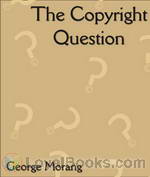 The Copyright Question
The Copyright Question
This is a letter to the Toronto Board of Trade regarding Canadian copyrights. Morang requested an appearance before the Toronto Board of Trade but was denied. This is his letter in response. He wished to make clear his position. | |
By: George Raffalovich (1880-1958) | |
|---|---|
 Ukraine
Ukraine
“We are not the same nation with Russian people,” the statement which all Ukrainians wish to convey to the whole world for centuries. The striving for freedom and independence is what these people shed much of their blood on Ukrainian lands for. “The Ukraine” by Bedwin Sands describes Ukrainian problem, which exacerbated in the late 19th and early 20th centuries, by looking back at the Ukrainian history, the development of Ukrainian literature and its influence, and by considering its relations with Austria and Russia. | |
By: George Washburn Smalley (1833-1916) | |
|---|---|
 Anglo-American Memories
Anglo-American Memories
“These Memories [1911] were written in the first instance for Americans and have appeared week by week each Sunday in the New York Tribune…. they are mainly concerned with men of exceptional mark and position in America and Europe whom I have met, and with events of which I had some personal knowledge. There is no attempt at a consecutive story.” Smalley was an American journalist born in Massachusetts in 1833; he wrote from and about many places in America and Europe. - Summary by Book Preface and David Wales | |
By: George Washington Greene (1811-1883) | |
|---|---|
 Visits To The Dead In The Catacombs Of Rome
Visits To The Dead In The Catacombs Of Rome
This essay of a cultured observer, for many years United States consul in Rome, appeared in Harper's New Monthly Magazine, vol 10, issue 59, April, 1855, pp 577 - 600. | |
By: George Wharton James (1858-1923) | |
|---|---|
 What the White Race May Learn from the Indian
What the White Race May Learn from the Indian
People learn from other people, and races have forever learned from other races. Herein we are treated to an in-depth understanding of categorized social characteristics of the Native American peoples, primarily those of the western U.S. as they existed at the time of book publication . 'In dealing with [the Native Americans] as a race, a people, therefore, I do as I would with my own race, I take what to me seem to be racial characteristics, or in other words, the things that are manifested in the lives of the best men and women, and which seem to represent their habitual aims, ambitions, and desires.' - Summary by Roger Melin & book foreword | |
By: Giacomo Leopardi (1798-1837) | |
|---|---|
 Essays and Dialogues
Essays and Dialogues
"We would no more choose to feed the minds of our countrymen and women with the despairing utterances of the pessimist poet, than we would their bodies with hasheesh. Such melancholy as his clothed in such eloquent words may be the luxury of the idle; it is poison to those who have work to do in the world. It shuts out hope, the very spring of energy; it makes the cheerful steady pursuit of duty a thing utterly beyond human powers. For we can none of us stand alone. Either in human or divine love we must find the mainspring of all life worth living... | |
By: Giles Lytton Strachey (1880-1932) | |
|---|---|
 Eminent Victorians
Eminent Victorians
On Modern Library's list of 100 Best Non-Fiction books, "Eminent Victorians" marked an epoch in the art of biography; it also helped to crack the old myths of high Victorianism and to usher in a new spirit by which chauvinism, hypocrisy and the stiff upper lip were debunked. In it, Strachey cleverly exposes the self-seeking ambitions of Cardinal Manning and the manipulative, neurotic Florence Nightingale; and in his essays on Dr Arnold and General Gordon, his quarries are not only his subjects but also the public-school system and the whole structure of nineteenth-century liberal values. | |
By: Goldsworthy Lowes Dickinson (1862-1932) | |
|---|---|
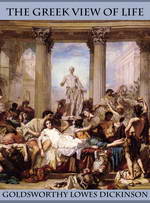 The Greek View of Life
The Greek View of Life
“With the Greek civilisation beauty perished from the world. Never again has it been possible for man to believe that harmony is in fact the truth of all existence.”This elegantly-written work provides a splendid introduction to the Greeks of the classic period: how they thought, wrote, and organised their lives and loves. Although it dates from the 1890s, there is very little about it that has dated. To its author’s credit, the subject of “Greek love” is dealt with in a sane and factual context - despite the judicial assassination of Oscar Wilde going on in the background... | |
By: Grenville Kleiser (1868-1953) | |
|---|---|
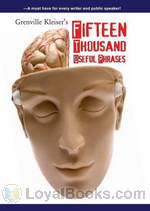 Fifteen Thousand Useful Phrases
Fifteen Thousand Useful Phrases
Fifteen Thousand Useful Phrases is a practical handbook written by Grenville Kleiser. Grenville is known for his writings on humor, positive thinking and inspirational thought. This serves as a handbook of pertinent expressions, striking similes and terms for embellishing speech and literature. This book can be used to improve vocabulary for reading, writing and speaking alike. Through mastery of words, the most powerful and perfect expression of thought can be delivered orally. Choosing the correct words conveys ideas in a crisp and clear way that will hold and audience's attention... | |
By: H. G. Wells (1866-1946) | |
|---|---|
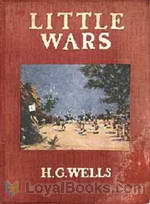 Little Wars (A Game for Boys)
Little Wars (A Game for Boys)
Miniature wargaming got its start with the publication in 1913 of this thoroughly entertaining little account of how H.G. Wells, with certain of his friends, took their childhood toys and turned play into acceptable middle-aged sport by subjecting the exercise to the civilizing influence of actual rules. While wargaming progressed far past these beginnings, Wells observes how “little wars” with even his elementary rules can suggest the wholesale crudity of the real thing. “You have only to play at Little Wars three or four times to realise just what a blundering thing Great War must be... | |
By: H. L. Mencken (1880-1956) | |
|---|---|
 Prejudices, First Series
Prejudices, First Series
Mencken sharpens his pen and in a collection of short essays delivers acerbic opinions on issues and persons of the time. Among his targets in this volume are critics, H.G. Wells Thorstein Veblen, Arnold Bennett, William Dean Howells, Irvin S. Cobb. Mencken's critiques are delivered against a background of his own well known ethnic, racial, religious, and sectional prejudices. Not for the faint of heart, Mencken's prickly, yet unapologetic, prose reveals a window into American attitudes at the time they were written and their influences on the larger American culture. - Summary by DrPGould | |
By: Hamilton Wright Mabie (1846-1916) | |
|---|---|
 Essays on Work and Culture
Essays on Work and Culture
The author investigates the world of work against a backdrop of culture. Each of the 25 essays focuses on one aspect of the topic. For example, the first essay, "Tool or Man?" looks at two views of man. One is that of strength as the provider of security. The other is that of aesthete, as an enthusiast of the arts or academics or religion. In our culture, provider of security is the winner every time. Man as a source of multiple talents cannot be allowed. As the author frames the argument, "Specialisation has been carried so far that it has become an organised tyranny... | |
By: Harl Vincent (1893-1968) | |
|---|---|
 Astounding Stories 02, February 1930
Astounding Stories 02, February 1930
This is the second issue of the classic science fiction Astounding Magazine. It contains the finale of The Beetle Horde by Victor Rousseau, as well as stories by Harl Vincent, Charles Willard Diffin, Hugh B. Cave, Sophie Wenzel Ellis, Sterner St. Paul, Anthony Pelcher and Captain S. P. Meek. | |
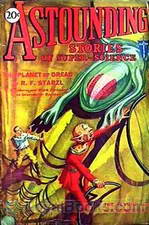 Astounding Stories 08, August 1930
Astounding Stories 08, August 1930
Issue eight of this seminal science-fiction magazine CONTENTS Murder Madness by Murray Leinster - the conclusion of this novel Earth the Maurader by Arthur J. Burks - Part 2 of a 3 Part novel as well as short Stories The Planet of Dread by R.F. Starxl, The Lord of Space by Victor Rousseau, The Second Satellite by Edmund Hamilton, Silver Dome by Harl Vincent and The Flying City by H. Thompson Rich | |
 Astounding Stories 10, October 1930
Astounding Stories 10, October 1930
Issue no. 10 of the magazine brings you:- Stolen Brains by Captain S.P. MeekThe Invisible Death by Victor Rousseau Prisoners on the Electron by Robert H. Leitfred Part 2 of Jetta of the Lowlands by Ray Cummings An Extra Man by Jackson Gee along with the Readers' Corner and interesting scientific facts | |
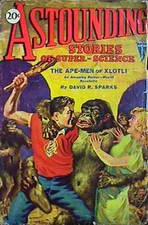 Astounding Stories 12, December 1930
Astounding Stories 12, December 1930
This issue includes "Slaves of the Dust" by Sophie Wenzel Ellis, Part B of "The Pirate Planet" by Charles W. Diffin, "The Sea Terror" by Captain S. P. Meek, "Gray Denim" by Harl Vincent, and "The Ape-Men of Xlotli" by David R. Sparks. | |
By: Harriet Martineau (1802-1876) | |
|---|---|
 Life in the Sick-room: Essays by an Invalid
Life in the Sick-room: Essays by an Invalid
Thinking she would be ill for the rest of her life, Harriet Martineau wrote these partly autobiographical essays about life in the sickroom. Considered ground breaking, it asserted that the sickroom is the sick person's place and not the doctor's. Sick people were able and willing to decide what is best for them. In England and abroad, people declared that "a sick person cannot write a healthy book" and that Harriet Martineau was definitely out of her senses. It would be interesting to see how much has changed. - Summary by Stav Nisser and Wikipedia. | |
By: Harry Bates, Editor | |
|---|---|
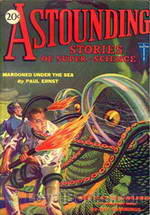 Astounding Stories of Super-Science, September 1930
Astounding Stories of Super-Science, September 1930
This is a collection of short science fiction stories by various writers, circa 1930. Writers include Paul Ernst, Miles Breuer, Ray Cummings, Sewell Wright, and others. | |